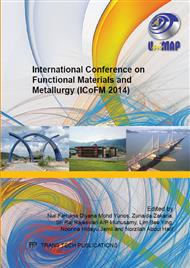[1]
M. Thackeray, Lithium ion batteries: An unexpected conductor, Natural Materials, 1 (2002) 81-82.
Google Scholar
[2]
M. Broussely, F. Perton and J. Labat, Li/LixNiO2 and Li/LixCoO2 rechargeable systems: compararative study and performance of practical cells, Journal of Power Sources, 43-44 (1993) 209-216.
DOI: 10.1016/0378-7753(93)80116-7
Google Scholar
[3]
S. -S. Shin, Y. -K. Sun, K. Amine, Synthesis and electrochemical properties of Li[Li(1-2x)/3NixMn(2-x)/3]O2, Journal of Power Sources, 112 (2002) 634-638.
DOI: 10.1016/s0378-7753(02)00439-1
Google Scholar
[4]
T. Ohzuku, A. Ueda, M. Nagayama, Y. Iwakoshi and H. Komori, Comparative study of LiCoO2, LiNi1/2Co1/2O2 and LiNiO2for 4 Volt secondary lithium cells, Electrochimica Acta, 38 (1993) 1159-1167.
DOI: 10.1016/0013-4686(93)80046-3
Google Scholar
[5]
H. Arai, S. Okada, Y. Sakurai, J. -i. Yamaki, Thermal behavior of Li1-yNiO2 and the decomposition mechanism, Solid State Ionics, 109 (1998) 295-302.
DOI: 10.1016/s0167-2738(98)00075-7
Google Scholar
[6]
T.Q. Tan, S.P. Soo, A. Rahmat, J.B. Shamsul, Rozana A.M. Osman, Z. Jamal and M.S. Idris, A brief review of layered rock salt cathode materials for lithium ion batteries, Advanced Materials Research, 795 (2013) 245-250.
DOI: 10.4028/www.scientific.net/amr.795.245
Google Scholar
[7]
C. Delams and I. Saadoune, Electrochemical and physical properties of the LixNi1-yCoyO2 phases, Solid State Ionics, 53-56 (1993) 370-375.
DOI: 10.1016/0167-2738(92)90402-b
Google Scholar
[8]
C. Delmas, I. Saadoune and A. Rougier, The cycling properties of the LixNi1-yCoyO2electrode, Journal of Power Sources, 43-44 (1993) 595-602.
DOI: 10.1016/0378-7753(93)80208-7
Google Scholar
[9]
M.S. Idris and A.R. West, The effect on cathode performance of oxygen non-stoichiometry and interlayer mixing in layered rock salt LiNi0. 8Mn0. 1Co0. 1O2-δ, Journal of the Electrochemical Society, 154(4) (2012) A396-A401.
DOI: 10.1149/2.037204jes
Google Scholar
[10]
P. Periasamy, H. -S. Kim, S. -H. Na, S. -I Moon and J. -C. Lee, Synthesis and characterization of LiNi0. 8Co0. 2O2 prepared by a combustion solution method for lithium batteries, Journal of Power Sources, 132 (2004) 213-218.
DOI: 10.1016/j.jpowsour.2003.12.036
Google Scholar
[11]
M.S. Idris and R.A. M Osman, Determination of interlayer mixing and oxygen non-stoichiometry in LiNi0. 8Mn0. 1Co0. 1O2-δ using power diffraction data, Advanced Materials Research, 795 (2013) 464-468.
Google Scholar
[12]
M.S. Idris and R.A.M. Osman, Structure refinement strategy of Li-based complex oxides using GSAS-EXPGUI software package, Advanced Materials Research, 795 (2013) 479-482.
DOI: 10.4028/www.scientific.net/amr.795.479
Google Scholar


